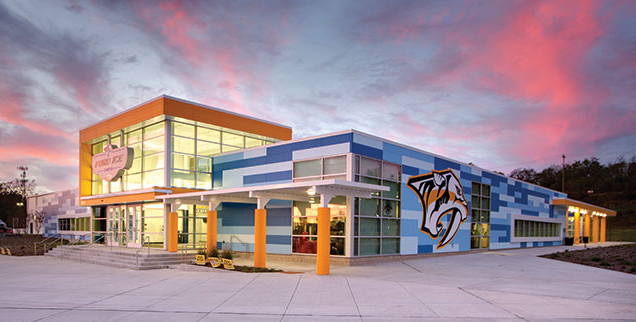What do you do with a struggling shopping complex? If you’re Nashville, you turn it into a community asset.
The city and the project team are taking the old Global Mall at the Crossings and breaking it into parts to provide different community services: a hockey practice arena, a library, and a community center.
“I see this center becoming a hub of learning and recreation for residents in Southeast Davidson County, one of the fastest growing parts of our city,” Mayor Karl Dean said when the project was first announced in 2013. “Families will find it convenient to have the ice rink, community center, park, and library in one location. This new public facility will benefit nearby neighborhoods and the surrounding retail and commercial area by attracting more people to the vicinity and creating a more stable business environment.”
For the design team, the challenge came with making those different functioning spaces work both separately and together, while also embracing a park that was formerly the mall’s parking lot.
As is the case with most malls, the original facade featured a beige brick exterior—not ideal for the three spaces that were to take over. “The building needed to be visually appealing to the end user,” says Tim Hamilton, owner of Dixie ICF who installed custom panels on the exterior of the building.
To create the more energetic feel they desired, the team turned to the vibrant colors possible with Nichiha’s Illumination Series fiber cement panels. Using Nichiha’s Color Xpression system that matches any paint manufacturer’s standard colors, the hockey center features blue Nichiha Illumination panels with gold accents, a nod to the city’s Predators National Hockey League team, the community center has blue mosaic, and the library features white with mosaic glass.
“We used Nichiha to tie it all together. Now it has a new strong identity for all three parts,” says Dan Meehan, AIA LEED-AP, principal with HBM Architects in Cleveland. “The scale of the building was a challenge because it was so large. We needed something to go across all three buildings. Now it gives a great feel.”
The timeline of the project was another challenge, Hamilton says. The 32,000 square feet of panels had to be installed in a six-week period. To overcome the aggressive schedule, Hamilton increased his manpower on the jobsite—and tapped into his nine years of experience using Nichiha products, making Nichiha the perfect fit for such a short construction schedule.
Meehan offers this advice to those looking to retrofit a large space into something completely different: “Look at it in context of its scale. The panel system was really important because of its virtually limitless color options.” Blue is used across all three areas, tying them together while allowing them to be their own spaces.
Challenge:
Rehab an old mall into three different spaces that are unique to themselves while complementing each other.
Solution:
The use of different color panels for each area allowed the three spaces to become their own with the use of blue pulling them all together.
Result:
A hockey arena, library, and community center work in concert visually, while leaving behind any appearance of an old mall.
Project Features
- Simple Installation
- Color Xpressions System, virtually limitless color palette options
- Timesaving Clip Installation System, reducing construction schedule and minimizing mistakes
- Low maintenance
Related Stories
| Aug 11, 2010
AAMA leads development of BIM standard for fenestration products
The American Architectural Manufacturers Association’s newly formed BIM Task Group met during the AAMA National Fall Conference to discuss the need for an BIM standard for nonresidential fenestration products.
| Aug 11, 2010
Embassy's dual façades add security and beauty
The British government's new 46,285-sf embassy building in Warsaw, Poland's diplomatic quarter houses the ambassador's offices, the consulate, and visa services on three floors. The $20 million Modernist design by London-based Tony Fretton Architects features a double façade—an inner concrete super structure and an outer curtain wall.
| Aug 11, 2010
Precast All the Way
For years, precast concrete has been viewed as a mass-produced product with no personality or visual appeal—the vanilla of building materials. Thanks to recent technological innovations in precast molds and thin veneers, however, that image is changing. As precast—concrete building components that are poured and molded offsite—continues to develop a vibrant personality all it...
| Aug 11, 2010
Seven tips for specifying and designing with insulated metal wall panels
Insulated metal panels, or IMPs, have been a popular exterior wall cladding choice for more than 30 years. These sandwich panels are composed of liquid insulating foam, such as polyurethane, injected between two aluminum or steel metal face panels to form a solid, monolithic unit. The result is a lightweight, highly insulated (R-14 to R-30, depending on the thickness of the panel) exterior clad...
| Aug 11, 2010
Nurturing the Community
The best seat in the house at the new Seahawks Stadium in Seattle isn't on the 50-yard line. It's in the southeast corner, at the very top of the upper bowl. "From there you have a corner-to-corner view of the field and an inspiring grasp of the surrounding city," says Kelly Kerns, project leader with architect/engineer Ellerbe Becket, Kansas City, Mo.
| Aug 11, 2010
AIA Course: Enclosure strategies for better buildings
Sustainability and energy efficiency depend not only on the overall design but also on the building's enclosure system. Whether it's via better air-infiltration control, thermal insulation, and moisture control, or more advanced strategies such as active façades with automated shading and venting or novel enclosure types such as double walls, Building Teams are delivering more efficient, better performing, and healthier building enclosures.
| Aug 11, 2010
Glass Wall Systems Open Up Closed Spaces
Sectioning off large open spaces without making everything feel closed off was the challenge faced by two very different projects—one an upscale food market in Napa Valley, the other a corporate office in Southern California. Movable glass wall systems proved to be the solution in both projects.







